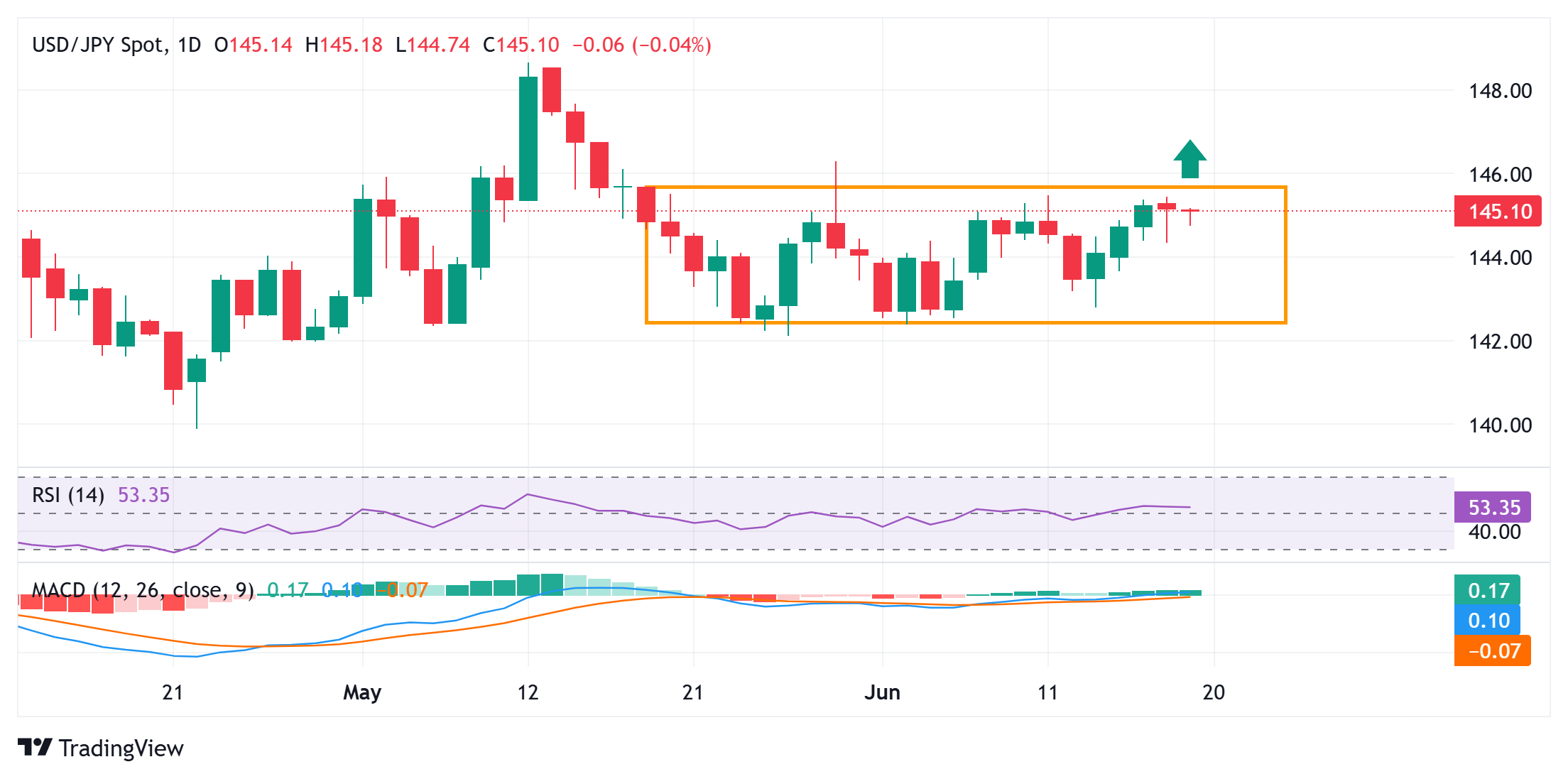Japanese Yen remains on the front foot as rising Middle East tensions underpin safe-haven assets
- The Japanese Yen trades with a mild positive bias amid reviving safe-haven demand.
- Reduced bets for a BoJ rate hike in 2025 and trade uncertainties cap gains for the JPY.
- The USD climbs to over one-week high and lends some support to the USD/JPY pair.
The Japanese Yen (JPY) edges higher against its American counterpart following the previous day's good two-way price moves amid the global flight to safety. Against the backdrop of the uncertainty surrounding US President Donald Trump's trade policies and rising geopolitical tensions in the Middle East, the Federal Reserve's (Fed) hawkish pause on Wednesday tempers investors' appetite for riskier assets. This helps revive demand for traditional safe-haven assets and in turn, underpins the JPY.
Meanwhile, the Bank of Japan's (BoJ) cautious approach to unwinding its decade-long monetary stimulus forced investors to push back their expectations about the likely timing of the next interest rate hike to Q1 2026. Apart from this, concerns about the potential economic fallout from existing 25% US tariffs on Japanese vehicles and 24% reciprocal levies on other imports might cap the JPY. This, along with the recent US Dollar (USD) bounce from a three-year low, supports the USD/JPY pair.
Japanese Yen attracts some safe-haven flows amid rising Middle East tensions
- The Federal Reserve, as was widely expected, kept interest rates steady at the end of a two-day policy meeting on Wednesday amid expectations of higher inflation ahead. In the closely watched “dot plot,” the committee indicated that two cuts by the end of 2025 are still on the table.
- Fed officials, however, forecasted a single quarter-percentage-point rate cut in each of 2026 and 2027. Moreover, seven of the 19 policymakers indicated they wanted no cuts this year, up from four in March, amid the risk that inflation could stay persistently higher and end the year at 3%.
- This comes on top of US President Donald Trump's remarks earlier this week, that tariffs on the pharma sector are coming soon, and weigh on investors' sentiment. This, along with geopolitical risks stemming from the Israel-Iran conflict, benefits the Japanese Yen's safe-haven status.
- As the Israel-Iran conflict enters its seventh day, reports suggest that US officials are preparing for a possible Iran strike this coming weekend. According to the Wall Street Journal, Trump approved attack plans for Iran but is holding off to see if Tehran will abandon its nuclear program.
- Meanwhile, Iran's Supreme Leader Ayatollah Ali Khamenei said in a national address that Iran will not surrender and warned that any US military intervention would result in irreparable damage. This, in turn, raises the risk of a broader regional conflict in the Middle East.
- On the trade-related front, Japan's Prime Minister Shigeru Ishiba said this week that we have not yet reached an agreement as there are still some differences between the two sides. This comes ahead of the July 9 deadline for higher reciprocal US tariffs and might cap the JPY.
- The US Dollar, on the other hand, stands near its highest level in over a week on the back of the Fed's hawkish pause. This is seen offering some support to the USD/JPY pair and warrants caution for bearish traders in the absence of any relevant US economic data on Thursday.
USD/JPY bulls await a breakout through the 145.45 hurdle before placing fresh bets

From a technical perspective, any further slide is likely to find decent support and might still be seen as a buying opportunity near the 144.50-144.45 area, below which the USD/JPY pair could slide to the 144.00 mark. A convincing break below the latter would expose the next relevant support near the 143.55-143.50 region before spot prices eventually drop to the 143.00 round figure en route to last Friday's swing low, around the 142.80-142.75 region.
On the flip side, the 145.45 area, representing the top end of a short-term trading range and the monthly swing high, might continue to act as an immediate hurdle. A sustained strength beyond will be seen as a fresh trigger for bullish traders. Given that oscillators on the daily chart have just started gaining positive traction, spot prices might then aim to conquer the 146.00 round figure before climbing further to the 146.25-146.30 region, or the May 29 peak.
Japanese Yen FAQs
The Japanese Yen (JPY) is one of the world’s most traded currencies. Its value is broadly determined by the performance of the Japanese economy, but more specifically by the Bank of Japan’s policy, the differential between Japanese and US bond yields, or risk sentiment among traders, among other factors.
One of the Bank of Japan’s mandates is currency control, so its moves are key for the Yen. The BoJ has directly intervened in currency markets sometimes, generally to lower the value of the Yen, although it refrains from doing it often due to political concerns of its main trading partners. The BoJ ultra-loose monetary policy between 2013 and 2024 caused the Yen to depreciate against its main currency peers due to an increasing policy divergence between the Bank of Japan and other main central banks. More recently, the gradually unwinding of this ultra-loose policy has given some support to the Yen.
Over the last decade, the BoJ’s stance of sticking to ultra-loose monetary policy has led to a widening policy divergence with other central banks, particularly with the US Federal Reserve. This supported a widening of the differential between the 10-year US and Japanese bonds, which favored the US Dollar against the Japanese Yen. The BoJ decision in 2024 to gradually abandon the ultra-loose policy, coupled with interest-rate cuts in other major central banks, is narrowing this differential.
The Japanese Yen is often seen as a safe-haven investment. This means that in times of market stress, investors are more likely to put their money in the Japanese currency due to its supposed reliability and stability. Turbulent times are likely to strengthen the Yen’s value against other currencies seen as more risky to invest in.

